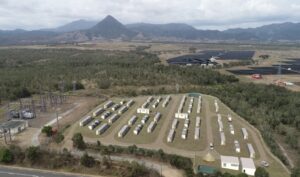The Queensland state government has unveiled plans to convert the Swanbank power hub – the site of a demolished coal generator and several generations of gas power plants – into a new green energy hub with a giant battery, as well as solar power and green hydrogen production.
The plan is to use the 1.2GW connection capacity at Swanbank, near the city of Ipswich west of Brisbane, into a clean energy hub, based initially around a 250MW, two hour (500MWh) big battery to be developed by the state-owned renewable power generator CleanCo.
The Swanbank battery has previously been foreshadowed – in the state’s clean power plan – as a 150MW/300MWh facility. But it appears now that the capacity has been boosted, given the increased need for storage as the state aims for 80 per cent renewables by 2035.
It is one of a number of big batteries that are being built by state owned generators, with the others being at Tarong, Stanwell, Kogan Creek and Greenbank. Most are using big grid connection points built for coal plants that have, or are about to be, retired.
The private sector is also heavily involved in battery storage, with Genex building the Bouldercombe battery (and the Kidston pumped hydro facility), and Neoen with plans for the Western Downs big battery, and Vena already completing the Wandoan South battery.
Numerous neighbourhood and pole mounted batteries are also being installed across the state-owned network.
The 336 hectare Swanbank site originally hosted two coal fired power stations (Swanbank A and B) whose last units were closed in 2005 and 2012 respectively, and a number of small gas generators (Swanbank C and D) that were closed in 2002 and 2004.
The existing 385MW Swanbank E generator was built in 2002, and despite its value being written down after being included in the portfolio of firming assets inherited by the then newly created CleanCo, it is a “combined cycle” gas generator that is regarded as a flexible unit suited for ramping up and down.
CleanCo CEO Tom Metcalfe says the company will seek community input into the design of the new clean energy hub, and is also seeking interest from providers of other technologies such as green hydrogen production and use, and other storage options.
“We are asking the community to reimagine the future of the Swanbank Clean Energy Hub to ensure we balance social, commercial, environmental and economic outcomes for the region,” he said in a statement.
“We will not just be asking “what do you think?” but rather, “what does the community need and value?” and “how can we collaborate to create the masterplan together and build enduring partnerships?” – and we are committed to delivering genuine outcomes from this process.”
Energy and hydrogen minister Mick de Brenni made much of the state-owned energy assets that allowed it to plan carefully for the green energy transition, with interim targets of 50 per cent by 2030 and 70 per cent buy 2032.
It should, however, be pointed out that Queensland has the lowest share of renewables, with just 23 per cent in the last 12 months, and the highest share of coal (72.1 per cent).
“While southern states like NSW are seeing a disorderly transition, where privatisation has ripped the heart out of their energy grid, Queenslanders can be assured that their energy system will be safe, stable, and secure for the future,” de Brenni said in a statement.
“Because we’ve kept the system in public ownership, we can control the transition by not shutting the gate on our power stations, their workers, or communities who will play a leading role in the energy transformation.”
See also RenewEconomy’s Big Battery Storage Map of Australia








